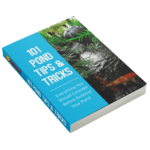There are many types of concrete pond sealers on the market today and the biggest problem for anyone looking for one is to know how to find the best product suited for the project at hand. You can search the internet and find a huge variety of sealers, but you have to ask yourself a few questions first.
- Which one is right for your application?
- How do you know what to ask the sales representative when you have questions?
- Will the coating harm my fish?
- How long is the sealer supposed to last?
Follow along and I will try to help you with choosing the right sealer.
The first thing most people should realize about concrete pond sealers is that there are big differences between products that claim to be a concrete pond sealer and those that actually are sealers, and by that I mean something that waterproofs. Typical concrete sealers are just a way to keep water from soaking in. They are sometimes oil based and usually have to be re-applied each year.
Knowing whether the coating is non toxic or not is very important when choosing a sealer because you need to make sure the sealer is safe for fish and plants if you plan to house aquatic life. There are many concrete pond sealers on the market today that will seal a pond up just fine but can be deadly to aquatic life even after the sealer has cured. You certainly do not want to lose your stock.
Next you need to think from an engineering stand point. Because there are so many different sealers out there, the actual properties of the sealer you choose can mean success or failure of your project. A few things you might want to keep in mind are tensile bond strength, elongation break strength as well as the quantity of solids that the actual sealer is made up of.
Did you know that certain types of solvents in a sealer are listed as volatile organic compounds (VOC)? VOCs are not only harmful to the environment, but they can also harm your aquatic life.
The tensile bond strength of the sealer you choose should be strong enough to not peel later. A peeling sealer will only cause you more problems later when you have to repair the problem. Pond Shield Epoxy, for instance, has a tensile bond strength that exceeds the internal strength of concrete, meaning it is not going to peel or flake off of a properly prepared surface.
Elongation break strength is closely related to the flexibility of the sealer. Elongation is the material’s ability to stretch before breaking. The break strength is how much force must be applied before the sealer breaks.
Everyone knows concrete can crack, so the trick is to find a sealer that will resist mimicking any cracks that may want to form. This will ensure that after the sealer has cured, hairline cracks that can form do not transfer through to the coating.
Going back to tensile strength, this is where most rubberized coating can have issues. The movement is too much for the coating to bear as it stretches causing the tensile strength the fail, later causing a peeling issue. Sometimes this looks like a bubble in the sealer.
Finally, there is the amount of solids that the sealer contains. This is very important. The reason is because a sealer that does not contain 100% solids in its makeup will then contain solvents and such instead. Remember, I referred to these as VOCs.
The problem with a pond sealer that contains solvents is two-fold. First, solvents might actually be toxic to aquatic life. Remember, just because a sealer is cured, does not mean it is not leeching off toxins into the water.
Pond Shield Epoxy is tested for toxicity is both its cured and uncured state to ensure that it will not harm aquatic life.
Finally, concrete pond sealers that contain solvents are also prone to shrinking during their curing process. What happens is the solvent evaporates out of the sealer and the over-all body of the sealer shrinks and a crack may form.
So pick a pond sealer that actually waterproofs, has no VOCs and is non toxic to the aquatic life you plan to house.


